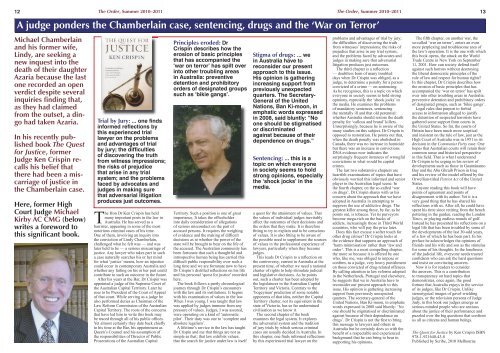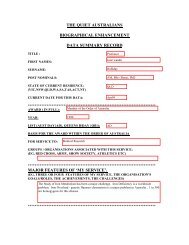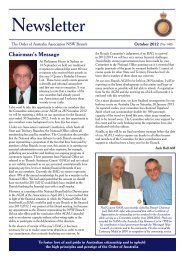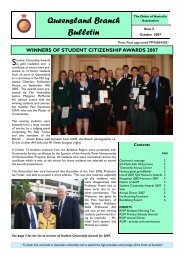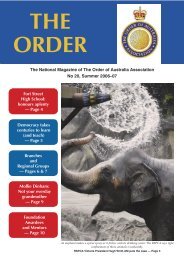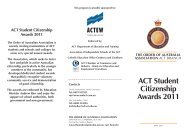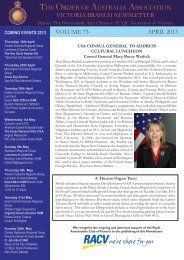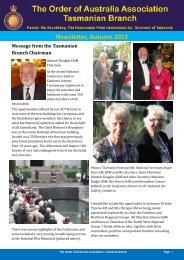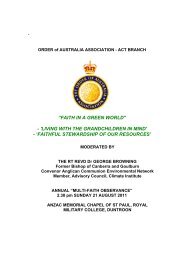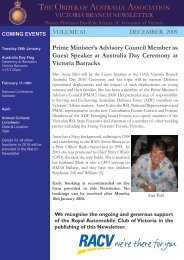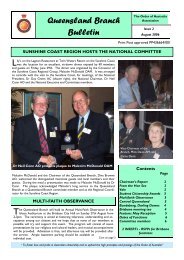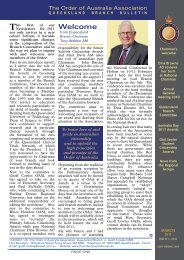The Order, Summer 2010â2011 - Order of Australia Association
The Order, Summer 2010â2011 - Order of Australia Association
The Order, Summer 2010â2011 - Order of Australia Association
- No tags were found...
Create successful ePaper yourself
Turn your PDF publications into a flip-book with our unique Google optimized e-Paper software.
12 <strong>The</strong> <strong>Order</strong>, <strong>Summer</strong> 2010–2011 <strong>The</strong> <strong>Order</strong>, <strong>Summer</strong> 2010–201113A judge ponders the Chamberlain case, sentencing, drugs and the ‘War on Terror’Michael Chamberlainand his former wife,Lindy, are seeking anew inquest into thedeath <strong>of</strong> their daughterAzaria because the lastone recorded an openverdict despite severalinquiries finding that,as they had claimedfrom the outset, a dingohad taken Azaria.In his recently publishedbook <strong>The</strong> Questfor Justice, formerJudge Ken Crispin recallshis belief thatthere had been a miscarriage<strong>of</strong> justice inthe Chamberlain case.Here, former HighCourt Judge MichaelKirby AC CMG (below)writes a foreword tothis significant book.Trial by Jury: ... one findsinformed reflections bythis experienced triallawyer on the problemsand advantages <strong>of</strong> trialby jury; the difficulties<strong>of</strong> discovering the truthfrom witness impressions;the risks <strong>of</strong> prejudicethat arise in any trialsystem; and the problemsfaced by advocates andjudges in making surethat adversarial litigationproduces just outcomes.<strong>The</strong> Hon Dr Ken Crispin has heldmany important posts in the law in<strong>Australia</strong>. He has served as abarrister, appearing in some <strong>of</strong> the mostnotorious criminal cases <strong>of</strong> his time.One <strong>of</strong> them, involving an inquiry intothe conviction <strong>of</strong> Lindy Chamberlain,challenged what he felt was — and waslater held to be — a serious miscarriage <strong>of</strong>justice. Any lawyer who takes part in sucha case naturally searches his or her mindfor what ‘justice’ means, how an injusticecould occur in contemporary <strong>Australia</strong> andwhether any failing on his or her part couldcontribute to such an outcome in the future.After his years at the Bar, Dr Crispin wasappointed a judge <strong>of</strong> the Supreme Court <strong>of</strong>the <strong>Australia</strong>n Capital Territory. Later herose to be President <strong>of</strong> the Court <strong>of</strong> Appeal<strong>of</strong> that court. While serving as a judge healso performed duties as Chairman <strong>of</strong> theLaw Reform Commission <strong>of</strong> the <strong>Australia</strong>nCapital Territory. <strong>The</strong> roots <strong>of</strong> the concernsthat have led him to write this book maybe traced through all <strong>of</strong> his public <strong>of</strong>fices.Yet almost certainly they date back chieflyto his time at the Bar, his appointment asQueen’s Counsel and his assumption <strong>of</strong>the responsibilities <strong>of</strong> Director <strong>of</strong> PublicProsecutions <strong>of</strong> the <strong>Australia</strong>n CapitalPrinciples eroded: DrCrispin describes how theerosion <strong>of</strong> basic principlesthat has accompanied the‘war on terror’ has spilt overinto other troubling areasin <strong>Australia</strong>: preventivedetention and prohibitoryorders <strong>of</strong> designated groupssuch as ‘bikie gangs’.Territory. Such a position is one <strong>of</strong> greatimportance. It takes the <strong>of</strong>ficeholderinto daily consideration <strong>of</strong> allegations<strong>of</strong> serious misconduct on the part <strong>of</strong>accused persons. It requires the weighing<strong>of</strong> evidence and the making <strong>of</strong> difficultdecisions as to whether the power <strong>of</strong> thestate will be brought to bear on the life <strong>of</strong>the accused. <strong>The</strong> <strong>Australia</strong>n community hasbeen fortunate that such a thoughtful andintrospective human being has carried thisdifficult public responsibility over such along time and we are fortunate now to haveDr Crispin’s distilled reflections on his lifeand his personal ‘quest for justice’ recordedhere.<strong>The</strong> book follows a partly chronologicaljourney through Dr Crispin’s encounterswith the law and its institutions. It beginswith his examination <strong>of</strong> values in the law.When I was young, I was taught that lawwas applied by judges immune from anypressure <strong>of</strong> values. Judges, I was assured,were operating on a kind <strong>of</strong> ‘automaticpilot’. <strong>The</strong>ir duty was one to ‘complete andabsolute legalism’.A lifetime’s service in the law has taughtDr Crispin and me that things are not assimple as that; that law exhibits values;that the search for justice under law is itselfStigma <strong>of</strong> drugs: ... wein <strong>Australia</strong> have toreconsider our presentapproach to this issue.His opinion is gatheringincreasing support frompreviously unexpectedquarters. <strong>The</strong> Secretary-General <strong>of</strong> the UnitedNations, Ban Ki-moon, inemphatic words expressedin 2008, said bluntly: “Noone should be stigmatisedor discriminatedagainst because <strong>of</strong> theirdependence on drugs.”Sentencing: ... this is atopic on which everyonein society seems to holdstrong opinions, especiallythe ‘shock jocks’ in themedia.a quest for the attainment <strong>of</strong> values. Thatthe values <strong>of</strong> individual judges inevitablyaffect the outcomes <strong>of</strong> their decisions andthe orders that they make. It is thereforefitting to try to explain and to be conscious<strong>of</strong> values. It is also fitting to be aware <strong>of</strong>the possible need to supplement the sources<strong>of</strong> values in the pr<strong>of</strong>essional experience <strong>of</strong>lawyers, particularly when they becomejudges.This leads Dr Crispin to a reflection onthe controversy, current in <strong>Australia</strong> at thepresent time, <strong>of</strong> whether we need a nationalcharter <strong>of</strong> rights to help stimulate judicialand legislative decisions. As he pointsout, such a charter has been adopted bythe legislatures in the <strong>Australia</strong>n CapitalTerritory and Victoria. Contrary to the‘bogeyman’ prediction <strong>of</strong> some notableopponents <strong>of</strong> that idea, neither the CapitalTerritory charter, nor its equivalent in thestate <strong>of</strong> Victoria, has so far underminedcivilisation as we know it.<strong>The</strong> second chapter <strong>of</strong> the bookexamines the legal system. It exploresthe adversarial system and the tradition<strong>of</strong> jury trials by which serious criminalcases are usually decided in <strong>Australia</strong>. Inthis chapter, one finds informed reflectionsby this experienced trial lawyer on theproblems and advantages <strong>of</strong> trial by jury;the difficulties <strong>of</strong> discovering the truthfrom witnesses’ impressions; the risks <strong>of</strong>prejudice that arise in any trial system;and the problems faced by advocates andjudges in making sure that adversariallitigation produces just outcomes.<strong>The</strong> third chapter is a reflection— doubtless born <strong>of</strong> many troubleddays when Dr Crispin was obliged, as ajudge, to determine a penalty for a personconvicted <strong>of</strong> a crime — on sentencing.As he recognises, this is a topic on whicheveryone in society seems to hold strongopinions, especially the ‘shock jocks’ inthe media. He examines the problems<strong>of</strong> mandatory sentences, sentencingthe mentally ill and that old perennial:whether <strong>Australia</strong> should restore the deathpenalty for ‘callous and brutal’ killers.Unsurprisingly, because he is aware <strong>of</strong> themany studies on this subject, Dr Crispin isopposed to restoration. He points out that,when the death penalty was abolished inCanada, there was no increase in homicidebut there was an increase in convictions.DNA evidence now indicates thesurprisingly frequent instances <strong>of</strong> wrongfulconvictions in what would be capitalcrimes.<strong>The</strong> last two substantive chapters areheartfelt examinations <strong>of</strong> topics that haveobviously worried this informed and seniorplayer in the <strong>Australia</strong>n legal scene. Inthe fourth chapter, on the so-called ‘waron drugs’, Dr Crispin shares with us hisconcern about the approach that we haveadopted in <strong>Australia</strong> in attempting tosuppress the use <strong>of</strong> addictive drugs. <strong>The</strong>greatest killer among these, by far, as hepoints out, is tobacco. Yet its purveyorsbecome mega-rich on the backs <strong>of</strong>addicts, increasingly those in Third Worldcountries, who will pay the price later.Does this fact excuse a s<strong>of</strong>ter touch forother drug crimes? Dr Crispin looks atthe evidence that supports an approach <strong>of</strong>‘harm minimisation’ rather than ‘law andorder’. This is a most compelling chapter,the more so because it is <strong>of</strong>fered by onewho, like me, was obliged to impose orconfirm, as a judge, very heavy punishmenton those convicted <strong>of</strong> drug-related <strong>of</strong>fences.By calling attention to law reforms adoptedin the Netherlands, Portugal and elsewhere,he suggests that we in <strong>Australia</strong> have toreconsider our present approach to thisissue. His opinion is gathering increasingsupport from previously unexpectedquarters. <strong>The</strong> secretary-general <strong>of</strong> theUnited Nations, Ban Ki-moon, in emphaticwords expressed in 2008 said bluntly: ‘Noone should be stigmatised or discriminatedagainst because <strong>of</strong> their dependence ondrugs’. Dr Crispin is not the first to bringthis message to lawyers and others in<strong>Australia</strong> but he certainly does so with thebenefit <strong>of</strong> a respectable and experiencedbackground that he can bring to bear insupporting his opinions.<strong>The</strong> fifth chapter, on another war, theso-called ‘war on terror’, enters an evenmore perplexing and troublesome area <strong>of</strong>the law’s operation. It is the one with whichthis book opens, the attack on the WorldTrade Centre in New York on September11, 2001. How can society defend itselfagainst such horrors without destroyingthe liberal democratic principles <strong>of</strong> therule <strong>of</strong> law and respect for human rights?In this chapter, Dr Crispin describes howthe erosion <strong>of</strong> basic principles that hasaccompanied the ‘war on terror’ has spiltover into other troubling areas in <strong>Australia</strong>:preventive detention and prohibitory orders<strong>of</strong> designated groups, such as ‘bikie gangs’.Legal rules that purport to forbidaccess to information alleged to justifythe detention <strong>of</strong> suspected terrorists havegathered some support from courts inthe United States. So far, the courts <strong>of</strong>Britain have been much more scepticaland insistent on the rule <strong>of</strong> law, just as theHigh Court <strong>of</strong> <strong>Australia</strong> was in 1951 in itsdecision in the Communist Party case. Onehopes that <strong>Australia</strong>n courts will retain theircommon sense and historical perspectivein this field. That is what I understandDr Crispin to be urging in his review <strong>of</strong>developments such as those in GuantánamoBay and the Abu Ghraib Prison in Iraqand his review <strong>of</strong> the model <strong>of</strong>fered by theOrwellian-titled Patriot Act <strong>of</strong> the UnitedStates.Anyone reading this book will havepoints <strong>of</strong> agreement and points <strong>of</strong>disagreement with its author. Yet it is avery good thing that he has shared hisreflections with us. After all, he could havespent his time since retiring from the benchpottering in the garden, reading the LondonTimes, or playing endless rounds <strong>of</strong> golf.Instead he has presented his reflections on alegal life that has been troubled by some <strong>of</strong>the developments <strong>of</strong> the last 30-odd years,<strong>of</strong> a few <strong>of</strong> which he has been part. In hispreface he acknowledges the opinions <strong>of</strong>friends and his wife and son as the stimulusfor some <strong>of</strong> his thoughts. In the loneliness<strong>of</strong> the judicial life, everyone needs trustedconfidants who can ask the hard questionsand insist on convincing answers.Now it is for readers to considerthe answers. This is a contributionto transparency on hard topics thatdemonstrates, once again, the goodfortune that <strong>Australia</strong> enjoys in the service<strong>of</strong> its judges, like Dr Crispin. Unlikestereotypical images <strong>of</strong> gavel-wieldingjudges, or the television persona <strong>of</strong> JudgeJudy, in this book our judges emerge asserious-minded people who are anxiousabout the justice <strong>of</strong> their performance andpuzzled over the big questions that confrontus all as citizens and human beings.<strong>The</strong> Quest for Justice by Ken Crispin ISBN978-1-921640-43-8Published by Scribe, 2010 Melbourne


